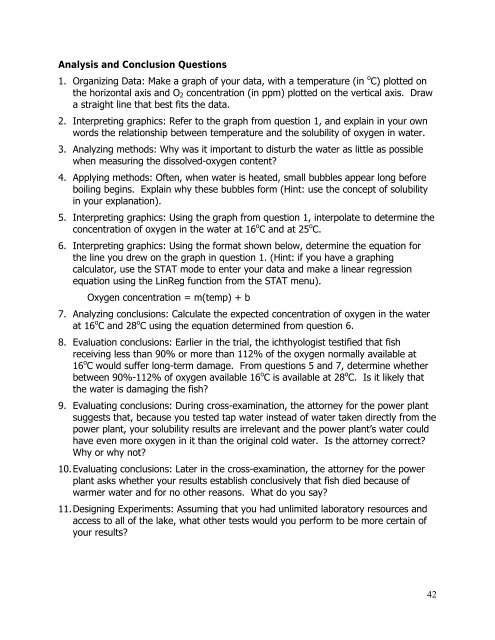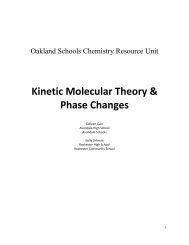Kinetic Molecular Theory Gas Laws - Oakland Schools
Kinetic Molecular Theory Gas Laws - Oakland Schools
Kinetic Molecular Theory Gas Laws - Oakland Schools
You also want an ePaper? Increase the reach of your titles
YUMPU automatically turns print PDFs into web optimized ePapers that Google loves.
Analysis and Conclusion Questions<br />
1. Organizing Data: Make a graph of your data, with a temperature (in o C) plotted on<br />
the horizontal axis and O 2 concentration (in ppm) plotted on the vertical axis. Draw<br />
a straight line that best fits the data.<br />
2. Interpreting graphics: Refer to the graph from question 1, and explain in your own<br />
words the relationship between temperature and the solubility of oxygen in water.<br />
3. Analyzing methods: Why was it important to disturb the water as little as possible<br />
when measuring the dissolved-oxygen content?<br />
4. Applying methods: Often, when water is heated, small bubbles appear long before<br />
boiling begins. Explain why these bubbles form (Hint: use the concept of solubility<br />
in your explanation).<br />
5. Interpreting graphics: Using the graph from question 1, interpolate to determine the<br />
concentration of oxygen in the water at 16 o C and at 25 o C.<br />
6. Interpreting graphics: Using the format shown below, determine the equation for<br />
the line you drew on the graph in question 1. (Hint: if you have a graphing<br />
calculator, use the STAT mode to enter your data and make a linear regression<br />
equation using the LinReg function from the STAT menu).<br />
Oxygen concentration = m(temp) + b<br />
7. Analyzing conclusions: Calculate the expected concentration of oxygen in the water<br />
at 16 o C and 28 o C using the equation determined from question 6.<br />
8. Evaluation conclusions: Earlier in the trial, the ichthyologist testified that fish<br />
receiving less than 90% or more than 112% of the oxygen normally available at<br />
16 o C would suffer long-term damage. From questions 5 and 7, determine whether<br />
between 90%-112% of oxygen available 16 o C is available at 28 o C. Is it likely that<br />
the water is damaging the fish?<br />
9. Evaluating conclusions: During cross-examination, the attorney for the power plant<br />
suggests that, because you tested tap water instead of water taken directly from the<br />
power plant, your solubility results are irrelevant and the power plant’s water could<br />
have even more oxygen in it than the original cold water. Is the attorney correct?<br />
Why or why not?<br />
10. Evaluating conclusions: Later in the cross-examination, the attorney for the power<br />
plant asks whether your results establish conclusively that fish died because of<br />
warmer water and for no other reasons. What do you say?<br />
11. Designing Experiments: Assuming that you had unlimited laboratory resources and<br />
access to all of the lake, what other tests would you perform to be more certain of<br />
your results?<br />
42
















